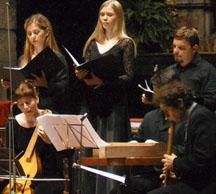2012-2013 Inaugural Season
2012-2013 Inaugural Season
Inaugural Concert
Inaugural Concert

The opening concert in the GEMAS series will be performed by lutenist Paul O’Dette. As one of the most influential figures in the early music field, Mr. O’Dette helped define the technical and stylistic standards to which 21st-century performers of early music aspire, infusing the performance practice movement with a careful combination of historical awareness, idiomatic accuracy, and self-expression. Known best for his recitals and recordings of virtuoso solo lute music, O’Dette maintains an active international career as an ensemble musician as well, performing with many of the leading early music soloists and ensembles such as the acclaimed continuo ensemble, Tragicomedia. In addition to his activities as a performer, O’Dette is an avid researcher, having worked extensively on the performance and sources of 17th-century Italian and English solo song, continuo practices, and lute technique. He is at work on a forthcoming book on lute technique co-authored by Patrick O’Brien. He has published numerous articles on issues of historical performance practice and co-authored the Dowland entry in the New Grove Dictionary of Music and Musicians. O’Dette is a professor of lute and director of early music at the Eastman School of Music, and serves as artistic director of the Boston Early Music Festival.
“¡Jácaras!”
Lutenist Paul O’Dette, performing 18th-century guitar music of Latin America composed by Santiago de Murcia, Manuel Alvarez, and anonymous Afro-Brazilian composers, including pieces from the Códice Saldívar No. 4, Cifras Selectas de Guitarra and Cifras de viola por varios autores (Coimbra).
Friday, November 9 at 7 pm [Note EARLY start time!]
Americas Society
680 Park Avenue
(between 68th and 69th Streets)
Tickets are $20, or free to Americas Society members.
A video sample, tickets, and more information are available here.
This concert is part of Carnegie Hall’s “Voices from Latin America” series this fall, which partners with outside organizations for performances in venues throughout the city.
Mala Punica- Italian Avant-gardes around 1400
 Mala Punica
Mala Punica
Italian Avant-gardes around 1400
Wednesday, March 6 at 7 pm
The Italian Academy at Columbia University
1161 Amsterdam Avenue
The renowned Argentine musicologist and virtuoso early-music performer Pedro Memelsdorff (also the new Director of world-famous Schola Cantorum Basiliensis (SCB) in Basel, Switzerland) brings his group Mala Punica to perform at the Italian Academy at Columbia University.
MORE INFO AND TICKETS
The Bishop’s Band
The Bishop’s Band
Directed by Tom Zajac and Nell Snaidas,
performs Music of late 18th-century Peru
from the Codex Trujillo del Perú
This concert made possible by the generous gifts of:
Anonymous
Mark Cortale
Anthony Elitcher & Kathryn Andrea Taras
Margorie Kitchell & Spencer Neth
Neil Plotkin & Deborah Malamud
Daniel and Ruth Shoskes
 Americas Society and GEMS present the third concert in the GEMAS series. Conceived and directed by multi-instrumentalist and early music specialist Tom Zajac, the program will feature soprano Nell Snaidas, along with an all-star cast of singers, instrumentalists and dancers in a selection of songs and dances from the 18th-century Peruvian Codex Trujillo del Perú along with mission music from the Moxos Archives of lowland Bolivia and sacred villancicos from the Cathedral of La Plata in what is now Sucre, Bolivia.
Americas Society and GEMS present the third concert in the GEMAS series. Conceived and directed by multi-instrumentalist and early music specialist Tom Zajac, the program will feature soprano Nell Snaidas, along with an all-star cast of singers, instrumentalists and dancers in a selection of songs and dances from the 18th-century Peruvian Codex Trujillo del Perú along with mission music from the Moxos Archives of lowland Bolivia and sacred villancicos from the Cathedral of La Plata in what is now Sucre, Bolivia.
Saturday, April 20 at 8 pm
Hispanic Society of America
Visitor entrance on Audubon Terrace
Broadway between 155th and 156th Streets
Manhattan
Tickets:
Free ~ Americas Society Members (AS members click here)
$25 ~ Non-members
Online sales for this event have ended.
Tickets will be available at the door at 7:30 PM.
Now held in the Royal Library in Madrid, the source of these songs and dances is a nine-volume collection of watercolor paintings mostly of flora and fauna that was presented to King Charles IV of Spain in the late 1780s by then Bishop of Trujillo, Baltazar Jaime Martínez Compañón. The collection is the end result of a 32-month visita, or official journey that the bishop undertook through the grasslands, deserts, mountains, rainforests and coastal plains surrounding Trujillo in his efforts to get to know the people, the geography and the resources of these regions. Volume II of the collection is devoted to portraits of people of all social strata, and includes, near the end of the book, paintings of dancers in colorful costumes and instrumentalists playing European violins, guitars, harps, bandolas, and pipes and tabors, as well as a number of indigenous and African wind and percussion instruments. Adjacent in the manuscript to these vibrant images are the scores of twenty pieces of music written in a very elegant classical-era hand. Each piece has a title that gives the form and a description (e.g. Tonada El Diamante – Tonada of the diamond), information about whether it is to be sung, or danced or both, and often the name of the town where it was collected. The subject matter of the vocal pieces varies greatly; there are love songs, a naughty sailors' song, a song of penitence in a near extinct native language, a song in the voice of an African slave decrying his condition, and a devotional song to the Virgin Mary. Just as the paintings depict local customs, these musical works are transcriptions of what was heard by the bishop's company in their travels and thus give a wonderful and rare snapshot of the traditions of late-18th century colonial music making.
The collection is best described as an early ethnomusicological gathering of local songs and dances. Certainly, one could imagine, if the bishop was on his visitain the early 20th century, that he would likely have had a cylinder or disk recorder with him to document the music, just as Bela Bartok did in his explorations of the Balkans, or John and Alan Lomax did on their journeys in the southern United States. So we have here an incredibly rare opportunity to hear, frozen in the amber of the 1780s, a moment in the development of a regional music, as it makes its way from the raw ingredients of European, African and Indigenous styles, to the true melding or creolization that we now think of as Andean or Peruvian music. The program also contains three sets of Bolivian music; the first, sacred villancicos from the Cathedral of La Plata, in what is now the modern city of Sucre; a set of three charming songs in the Canichanas Indian language from the Bolivian rain forest; and a diverse selection of instrumental and vocal pieces of a more popular nature from a collection called the Moxos archives from another Jesuit mission further to the north from the Canichanas region. The melodies are memorable, the harmonies are catchy, and the rhythms are lively and syncopated, announcing present-day Latin American popular music.
The concert will take place in the Hispanic Society’s beautiful Sorolla y Bastida Mural Gallery and will be accompanied by slide projections of the codex illustrations and supertitles of the translations of the texts, providing the listener with a wonderfully intimate and immediate experience, while Carlos Fittante, Robin Gilbert Campos, Bárbara Martínez and Ricardo Santiago - who specialize in Historical Performance and Flamenco respectively, will perform dances inspired by the paintings.
This concert will be a soldout event so plan to get your tickets early.
The Bishop’s Band
SINGERS
Nell Snaidas - tiple primero
Jennifer Ellis-Kampani - tiple segundo
Daniela Tošić - alto
Jason McStoots - tenor
Paul Guttry - bajo
STRINGS
Robert Mealy - violín primero
Holly Piccoli - violín segundo
Michael Unterman - cello
WINDS
Nina Stern - recorders
Priscilla Smith - recorders
BASSO CONTINUO AND RHYTHM SECTION
Grant Herreid - guitar, theorbo
Scott Pauley - guitar, theorbo
Paul Shipper - guitar, percussion
Paula Fagerberg - Spanish cross-strung harp
Danny Mallon - percussion
Tom Zajac - percussion and winds
DANCERS
Bárbara Martínez
Ricardo Santiago
Carlos Fittante
Robin Gilbert Campos
This is the second of two performances inspired by the music of the Trujillo del Perú Manuscript to be presented in April by Americas Society. The first concert, Codex I, will take place on April 7th at 4 pm and will feature the premieres of four pieces commissioned by AS from internationally known composers written for members of ICE, International Contemporary Ensemble. Click here for further information on this concert.
Meridionalis & Clarion Music Society- Bolivian Baroque
 Meridionalis & Clarion Music Society- Bolivian Baroque
Meridionalis & Clarion Music Society- Bolivian Baroque
Tuesday, April 30 at 6 pm
St. Paul’s Chapel @ Columbia University
Free admission
The final event of the inaugural GEMAS season is a concert that features Americas Society's critically acclaimed vocal ensemble Meridionalis (Sebastián Zubieta, director) and instrumentalists from the distinguished Clarion Society (Steven Fox, director) ina concert of music written in the Jesuit missions of eastern Bolivia during the 18th century. This concert presents instrumental and choral works from one of America's great baroque musical centers and will be heard in the perfect setting, St. Paul's Chapel at Columbia University.
CLICK HERE FOR MORE INFO

